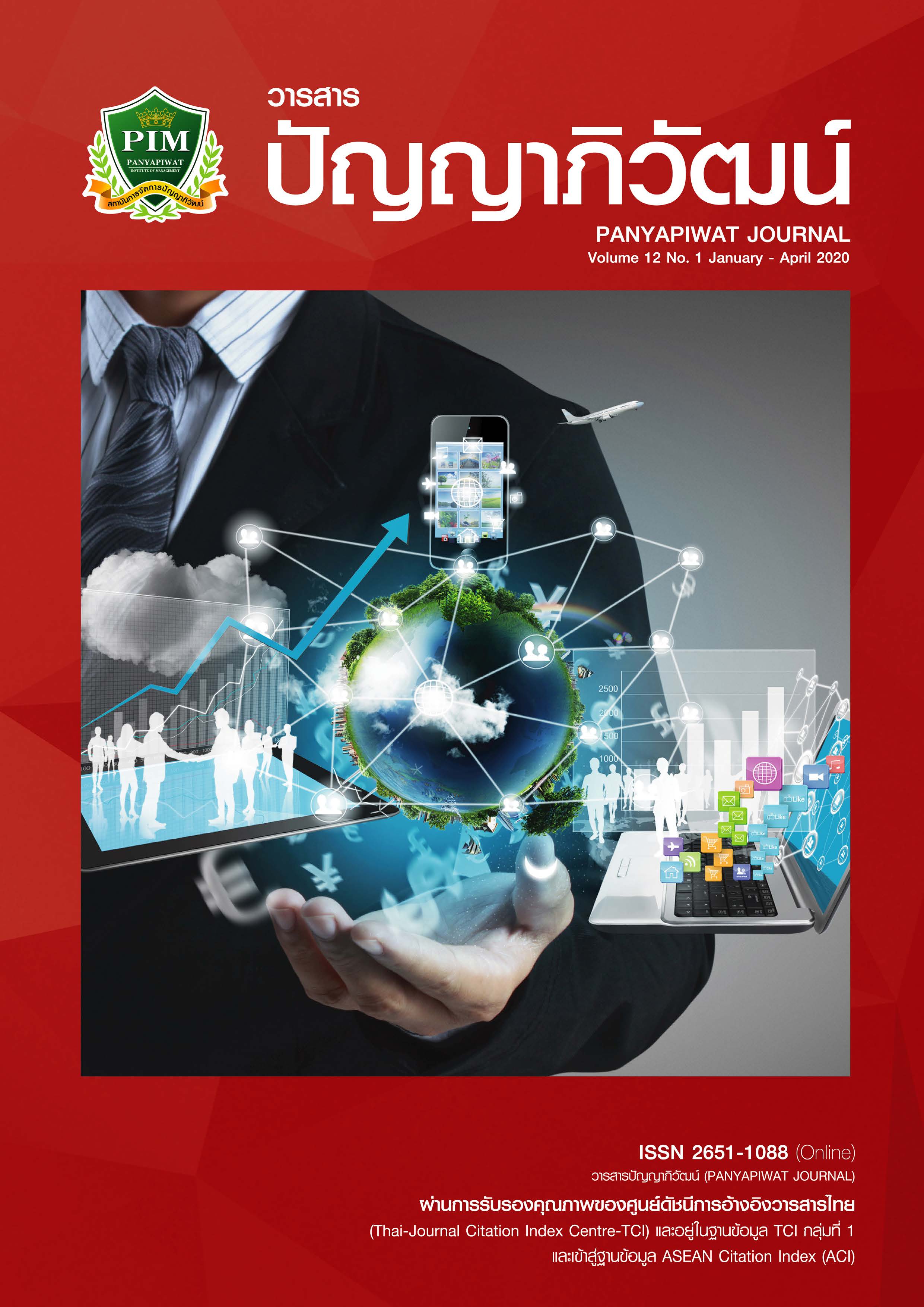ลักษณะองค์การที่เป็นเลิศที่มีต่อผลการดำเนินงานของธุรกิจขนาดกลางและขนาดย่อม ในเขตภาคตะวันออกเฉียงเหนือของประเทศไทย
Main Article Content
บทคัดย่อ
การวิจัยนี้มีวัตถุประสงค์เพื่อทราบถึง 1) ลักษณะองค์การที่เป็นเลิศ และ 2) ผลการดำเนินงานและลักษณะองค์การที่เป็นเลิศที่มีต่อผลการดำเนินงานของธุรกิจขนาดกลางและขนาดย่อมในเขตภาคตะวันออกเฉียงเหนือ ของประเทศไทย กลุ่มตัวอย่างเป็นผู้บริหารของธุรกิจขนาดกลางและขนาดย่อมในเขตภาคตะวันออกเฉียงเหนือของประเทศไทยทั้งหมด 12 จังหวัด การสุ่มเลือกกลุ่มตัวอย่างด้วยวิธีการสุ่มเลือกแบบเจาะจง จำนวน 400 ราย พบว่า ลักษณะขององค์การที่เป็นเลิศในภาพรวมสอดคล้องกับการปฏิบัติงานจริงในระดับมาก ( X = 4.080, S.D. = 0.892) โดยภาพรวมสอดคล้องกับการปฏิบัติงานจริงในระดับมากในทุกด้าน ได้แก่ ด้านการนำองค์การ ( X = 3.865, S.D. = 0.910) ด้านการวางแผนเชิงกลยุทธ์ ( X = 4.062, S.D. = 0.835) ด้านการมุ่งเน้นลูกค้า ( X = 3.723, S.D. = 0.946) ด้านการวัด การวิเคราะห์ และการจัดการความรู้ ( X = 3.967, S.D. = 0.820) ด้านการมุ่งเน้นบุคลากร ( X = 4.130, S.D. = 0.872) ด้านการมุ่งเน้นการปฏิบัติการ ( X = 3.715, S.D. = 0.965) ผลการดำเนินงานด้านผลลัพธ์ ด้านการเงิน ในภาพรวมอยู่ในระดับที่เพิ่มขึ้นเมื่อเทียบกับเป้าหมาย ( X = 3.952, S.D. = 0.814) ซึ่งด้านที่มีความสัมพันธ์ระหว่างผลการดำเนินงาน ได้แก่ การนำองค์การ (r = 0.610, Sig = 0.000) การวัด การวิเคราะห์ และการจัดการความรู้ (r = -0.160, Sig = 0.001) การมุ่งเน้นบุคลากร (r = -0.156, Sig = 0.002) ส่วนด้านที่ไม่มีความสัมพันธ์ ได้แก่ การวางแผนเชิงกลยุทธ์ (r = -0.001, Sig = 0.977) การมุ่งเน้นลูกค้า (r = -0.090, Sig = 0.071) การมุ่งเน้น การปฏิบัติการ (r = 0.077, Sig = 0.124) มีนัยสำคัญทางสถิติที่ระดับ 0.01
Article Details
“ข้าพเจ้าและผู้เขียนร่วม (ถ้ามี) ขอรับรองว่า บทความที่เสนอมานี้ยังไม่เคยได้รับการตีพิมพ์และไม่ได้อยู่ระหว่างกระบวนการพิจารณาลงตีพิมพ์ในวารสารหรือแหล่งเผยแพร่อื่นใด ข้าพเจ้าและผู้เขียนร่วมยอมรับหลักเกณฑ์การพิจารณาต้นฉบับ ทั้งยินยอมให้กองบรรณาธิการมีสิทธิ์พิจารณาและตรวจแก้ต้นฉบับได้ตามที่เห็นสมควร พร้อมนี้ขอมอบลิขสิทธิ์บทความที่ได้รับการตีพิมพ์ให้แก่สถาบันการจัดการปัญญาภิวัฒน์หากมีการฟ้องร้องเรื่องการละเมิดลิขสิทธิ์เกี่ยวกับภาพ กราฟ ข้อความส่วนใดส่วนหนึ่งและ/หรือข้อคิดเห็นที่ปรากฏในบทความข้าพเจ้าและผู้เขียนร่วมยินยอมรับผิดชอบแต่เพียงฝ่ายเดียว”
เอกสารอ้างอิง
Akdemir B., Erdem O. & Polat S. (2010). Characteristics of High Performance Organizations. The Journal of Faculty of Economics and Administrative Sciences, 15(1), 155-174.
Balaguer, E., Cheese, P. & Marchetti, C. (2006). The High-Performance Workforce Study 2006. Retrieved October 31, 2017, from https://www.immagic.com/eLibrary/ARCHIVES/ GENERAL/ACNTR_BM/A061019B.pdf
Jones G. (2010). High-performance leadership: Turning pressure to your advantage. Human Resource Management International Digest, 12(7), 34-38.
Kennedy J. W. (2010). Empowering Future Organizational Leaders for the 21st Century. International Business & Economic Research Journal, 9(4), 152-163.
Khan, S. N. (2010). Impact of Authentic Leaders on Organization Performance. International Joumal of Business and Management, 9(4), 145-148.
Lawler, E. E. (2005). Creating High Performance Organization. Asia Pacific Journal of Human Resource, 43(10), 20-31.
Lear, G. (2009). The Dynamics of High Performing Organizations. Resource Development Systems LLC. Retrieved October 25, 2017, from https://www.rds-net.com/documents/
The%20Dynamics%20of%20High%20Performing%20Organizations%202009.pdf
Narayan A. & Johnson D. S. (2012). Individual and relational self-concepts in a team context: Effects on task perceptions, trust, intrinsic motivation, and satisfaction. Team Performance Management, 18(5-6), 236-255.
Office of Thailand Quality Award. (2012). Thailand Quality Award Criteria of 2012-2013. Bangkok: Phongwarin Printing Co., Ltd. [In Thai]
Pongwiritthon, R., Parkvipas, P. & Songsiriroj, S. (2015). Marketing Mix Factors Affecting Buying Decision of Textile Handicraft from Lanna’s Ethnic Wisdom: Pgazkoenyau. Panyapiwat Journal, 9(1), 25-36. [in Thai]
Richards, D. & Medhurst, D. (2010). Thought on the definition of organization excellence. D&D Excellence Ltd. Retrieved January 25, 2017, from www.ddexcellence.com
Samson, D. & Challis, D. (2002). Manufacturing and Operations Strategy. Prentice Hall of Australia: Melbourne.
Thailand Quality Award. (2009). TQM and TQA, or it is just the different name. Product World. November-December 2009. Retrieved January 25, 2017, from https://www.tqa.or.th/ criteria /html5/ index.html?&locale=THA [in Thai]
The Office of SMEs Promotion. (2016). The Small and Medium-sized Enterprises situation report of year 2015 and the trends of year 2016. Bangkok: The Office of SMEs Promotion. [in Thai]
The Stock Exchange of Thailand. (2013). The latest form 56-1 of year 2012 of the companies listed on the Stock Exchange of Thailand. Retrieved December 12, 2016, from https://www.set.or.th/set/commonslookup.do?language=th&country=TH [in Thai]
Yamane. (1967). Taro Statistic: An Introductory Analysis. New York: Harper & row.


